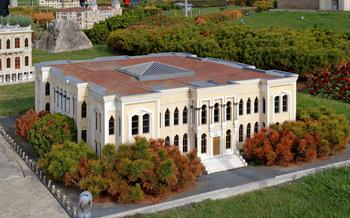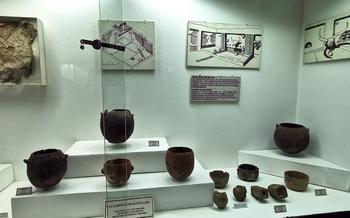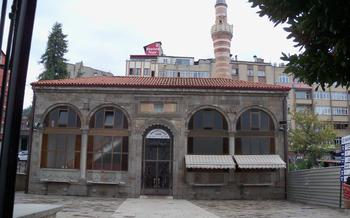
The Historical Inns of Isparta
- History of Isparta’s Historical Inns
- Location of the Historical Inns
- Types of Historical Inns
- Architecture of the Historical Inns
- Interior of the Historical Inns
- Historical Significance of the Inns
- Current Use of the Historical Inns
- The Haci Ipsirli Inn
- The Hanim Inn
- The Gümüş Inn
- The Kervansaray Inn
- The Taş Inn
- The Yeni Inn
- Personal Experience
- Insider Tip
History of Isparta’s Historical Inns
Isparta’s historical inns are a testament to the city’s rich history and vibrant culture. They have been around for centuries, with the earliest ones dating back to the 13th century. These inns were built by wealthy merchants and travelers who needed a place to stay while passing through the city. They were also used by pilgrims who were on their way to Mecca. The inns were designed to provide a comfortable and safe place to stay, and they often featured amenities such as stables, restaurants, and baths. Over time, the inns became an important part of Isparta’s social and cultural life, and they played a role in the city’s development.
Location of the Historical Inns
The historical inns of Isparta are mostly concentrated in the city center, within walking distance of each other. They are situated in the historic district of Isparta, which is known for its narrow cobblestone streets, traditional Ottoman houses, and historical landmarks.
Some of the inns are located on or near the main pedestrian street of Isparta, making them easily accessible and surrounded by shops, restaurants, and cafes. Others are tucked away in quiet side streets, offering a more peaceful and secluded atmosphere.
The inns are all within easy reach of Isparta's other major attractions, such as the city's museums, mosques, and churches. The Isparta Museum, which houses a collection of artifacts from the city's rich history, is just a short walk away. The historic Ulu Mosque, with its impressive dome and minarets, is also nearby.
Public transportation in Isparta is convenient and affordable, making it easy to get around the city and visit the historical inns. Buses and minibuses run frequently and connect the city center with other parts of Isparta. The inns are all located within walking distance of bus stops, making them easily accessible for visitors without their own transportation.
Types of Historical Inns
Isparta's historical inns can be broadly categorized into two types: kervansarays and hans. Kervansarays were primarily built to accommodate traveling merchants and their caravans, while hans were intended for more permanent residents, such as artisans and traders. Kervansarays are typically larger and more elaborate than hans, with spacious courtyards, stables, and multiple rooms for guests. Hans, on the other hand, are generally smaller and more intimate, with a focus on providing comfortable living quarters for their tenants.
Among the most famous and unique inns in Isparta is the Hacı İpsirli Inn. This 17th-century kervansaray is renowned for its stunning architecture, which features a grand entrance gate, a central courtyard surrounded by two-story arcades, and a series of beautifully decorated guest rooms. Another notable inn is the Hanim Inn, a 19th-century han that was once a popular gathering place for local merchants and traders. The Hanim Inn is known for its intricate woodwork, colorful stained-glass windows, and a charming courtyard that exudes a sense of tranquility.
In terms of services and amenities, the historical inns of Isparta offer a range of options to suit different needs and budgets. Some inns provide basic amenities such as simple bedding and shared bathrooms, while others offer more luxurious accommodations with private rooms, modern bathrooms, and air conditioning. Many of the inns also have on-site restaurants or cafes that serve traditional Turkish cuisine and beverages. Price ranges vary depending on the type of inn, the level of amenities offered, and the time of year.
Architecture of the Historical Inns
The historical inns of Isparta are renowned for their distinctive architectural style, which blends traditional Ottoman elements with local influences. Constructed primarily of stone and wood, these inns showcase intricate carvings, arched doorways, and decorative tilework. The interiors are adorned with colorful frescoes and murals depicting scenes from Turkish history and mythology. Many of the inns feature charming courtyards with fountains and lush gardens, providing a tranquil oasis for weary travelers.
Over the years, the inns have undergone renovations and modifications to adapt to changing needs and tastes. However, they have retained their original charm and character, thanks to careful restoration efforts. Visitors can admire the intricate craftsmanship and attention to detail that went into the construction of these historic buildings.
Interior of the Historical Inns
The interiors of the historical inns in Isparta are a testament to the craftsmanship and artistry of the past. The rooms are typically decorated with intricate carvings, colorful tiles, and beautiful rugs. The furnishings are simple but elegant, and the beds are often adorned with intricate bedspreads and pillows. Many of the inns also feature unique architectural details, such as stained glass windows, vaulted ceilings, and marble fireplaces.
The ambiance and atmosphere of the inns are warm and inviting. The thick walls and heavy doors help to keep out the noise and heat of the city, creating a peaceful and relaxing environment. The inns are also known for their friendly and welcoming staff, who are always happy to help guests with anything they need.
Historical Significance of the Inns
The historical inns of Isparta played a pivotal role in the city's development, serving as essential stopovers for travelers and traders traversing the region. These inns were not merely places of accommodation but vibrant hubs of cultural exchange and social interaction. They hosted numerous important events and gatherings, including religious ceremonies, weddings, and political meetings.
Many renowned figures have graced the halls of these inns, leaving an indelible mark on their storied history. Merchants, pilgrims, artists, and statesmen sought refuge within these walls, sharing tales of their journeys and experiences. Among the illustrious guests who have graced these inns, the names of Mustafa Kemal Atatürk, the founder of the Turkish Republic, and the renowned traveler Evliya Çelebi stand out.
Over the centuries, legends and stories have become intertwined with the history of these inns. Locals and visitors alike whisper tales of hidden treasures, secret passages, and ghostly apparitions that haunt the corridors of these ancient establishments. These stories add an air of mystery and intrigue, further captivating visitors who come to explore these historical gems.
Current Use of the Historical Inns
Many of Isparta's historical inns are still in operation today, offering a unique and atmospheric experience for visitors. Some have been converted into hotels or guesthouses, while others have been transformed into restaurants, cafes, or museums. The inns have been carefully restored and renovated to preserve their original character and charm, while also incorporating modern amenities and conveniences.
However, the inns face several challenges in the modern era. One challenge is the increasing cost of maintaining and restoring these historic buildings. Another challenge is the need to balance the needs of modern tourism with the preservation of the inns' historical integrity. Despite these challenges, the inns remain an important part of Isparta's cultural heritage and continue to attract visitors from around the world.
The Haci Ipsirli Inn
The Haci Ipsirli Inn is one of the most renowned historical inns in Isparta. Built in the 17th century by a wealthy merchant named Haci Ipsirli, the inn was originally used to accommodate travelers and traders passing through the city. Over the years, the inn has undergone several renovations and restorations, but it still retains its original architectural features and charm.
The Haci Ipsirli Inn is a two-story building with a courtyard in the center. The exterior of the inn is made of stone and features intricate carvings and decorations. The interior of the inn is decorated with traditional Turkish motifs and patterns. The inn has a total of 30 rooms, each of which is equipped with modern amenities such as air conditioning, heating, and private bathrooms.
Today, the Haci Ipsirli Inn is a popular tourist destination. Visitors can stay at the inn and experience the traditional Turkish hospitality. The inn also has a restaurant that serves delicious Turkish cuisine.
During my visit to the Haci Ipsirli Inn, I was struck by its beauty and charm. The inn's courtyard was a particularly peaceful and relaxing place to sit and enjoy a cup of tea. I would highly recommend the Haci Ipsirli Inn to anyone visiting Isparta.
The Hanim Inn
The Hanim Inn is another historical inn located in the city center of Isparta, Turkey. It was built in the 17th century by a wealthy merchant named Hanim Ağa. The inn is a two-story building with a courtyard and a garden. The exterior of the inn is made of stone and brick, and the interior is decorated with wood paneling and colorful tiles.
The Hanim Inn has a total of 12 rooms, each of which is furnished with traditional Turkish furniture and textiles. The rooms are also equipped with modern amenities such as air conditioning and Wi-Fi. The inn also has a restaurant that serves traditional Turkish cuisine, as well as a bar and a lounge.
The Hanim Inn is a popular destination for both tourists and locals. It is a great place to stay for those who want to experience the history and culture of Isparta. The inn is also a great base for exploring the city's many other attractions, such as the Isparta Museum, the Süleyman Demirel University, and the Eğirdir Lake.
The Gümüş Inn
The Gümüş Inn is another one of Isparta's historical inns, known for its elegant architecture and warm hospitality. Built in the 18th century, the inn has stood the test of time, retaining its original charm and character. Its name, "Gümüş" meaning "silver" in Turkish, hints at the inn's luxurious past when it was a popular stopover for wealthy merchants and travelers.
The inn's exterior features intricate stone carvings, decorative arches, and a grand entrance that invites guests into a world of history and tradition. Inside, the Gümüş Inn boasts spacious rooms with high ceilings, traditional Turkish furnishings, and cozy fireplaces. The courtyard, a central feature of the inn, is a serene oasis with a fountain, lush greenery, and comfortable seating areas.
Over the years, the Gümüş Inn has undergone careful restoration to preserve its historical integrity while providing modern amenities for guests. Today, it operates as a boutique hotel, offering visitors a unique and immersive experience of Isparta's rich cultural heritage. Whether you're a history buff, a lover of architecture, or simply seeking a peaceful retreat, the Gümüş Inn is an excellent choice for your stay in Isparta.
The Kervansaray Inn
The Kervansaray Inn, also known as the "Caravanserai Inn," is one of the most historically significant inns in Isparta, dating back to the 16th century. Built during the Ottoman period, this inn served as a resting place for weary travelers and traders who traversed the ancient trade routes that passed through the region. The inn's strategic location made it a popular stopover for caravans carrying goods to and from the bustling markets of the Ottoman Empire.
The Kervansaray Inn boasts a unique architectural style that reflects its historical significance. Its imposing stone facade, adorned with intricate carvings and decorative elements, hints at the grandeur of the bygone era. Inside, the inn features a spacious courtyard surrounded by a series of rooms that were once used to accommodate travelers. These rooms are adorned with traditional Turkish motifs, arched doorways, and colorful tiles, creating an ambiance that transports visitors back in time.
Originally built to cater to the needs of merchants and traders, the Kervansaray Inn has undergone extensive renovations over the years. Today, it has been transformed into a charming hotel that seamlessly blends modern amenities with its historical charm. Visitors can choose from a variety of rooms, each offering a unique blend of comfort and authenticity.
For history buffs and architecture enthusiasts, a visit to the Kervansaray Inn is a must. The inn's rich past and captivating ambiance offer a glimpse into the cultural heritage of Isparta and the pivotal role it played in the region's history. Whether you're seeking a comfortable stay or simply exploring the city's historical landmarks, the Kervansaray Inn promises an unforgettable experience.
The Taş Inn
The Taş Inn is one of the most prominent historical inns in Isparta, with a history dating back to the 18th century. Constructed during the Ottoman Empire, it served as a crucial stopover for travelers and traders traversing the region. The inn's name, "Taş," translates to "stone" in Turkish, reflecting the sturdy stone construction that has stood the test of time.
The Taş Inn showcases a blend of traditional Ottoman and Seljuk architectural styles. Its exterior features intricate stone carvings and arched doorways, while the interior boasts spacious courtyards adorned with columns and decorative tiles. The inn's rooms are designed with comfort in mind, offering a glimpse into the lifestyle and hospitality of a bygone era.
Today, the Taş Inn has been meticulously restored and transformed into a charming boutique hotel, providing a unique accommodation experience for visitors seeking a taste of history and authenticity. Guests can immerse themselves in the inn's rich heritage while enjoying modern amenities and personalized service.
Visiting the Taş Inn is like stepping back in time, offering a tangible connection to Isparta's storied past. Whether you're a history buff, an architecture enthusiast, or simply seeking a unique travel experience, the Taş Inn is an absolute must-visit destination.
The Yeni Inn
The Yeni Inn is one of the newest historical inns in Isparta, dating back to the early 19th century. It was built by a wealthy merchant named Hüseyin Efendi, who wanted to create a comfortable and luxurious place for travelers to stay. The inn is located in the heart of the city, just a short walk from the main square. It is a large and imposing building, with a grand entrance and a beautiful courtyard. The interior of the inn is just as impressive, with high ceilings, marble floors, and intricate woodwork. The inn offers a variety of services and amenities, including a restaurant, a bar, and a spa. It is also a popular venue for weddings and other special events.
Personal Experience
I had the opportunity to stay at the Yeni Inn during my recent trip to Isparta. I was immediately impressed by the inn's beautiful architecture and its warm and welcoming atmosphere. The staff was very friendly and helpful, and they made sure that I had everything I needed. My room was spacious and comfortable, with a large bed and a private bathroom. I also enjoyed the inn's restaurant, which served delicious Turkish cuisine. Overall, I had a wonderful stay at the Yeni Inn, and I would highly recommend it to anyone visiting Isparta.
Insider Tip
In addition to the well-known inns mentioned above, Isparta is home to a number of lesser-known inns that are equally charming and atmospheric. For a truly unique experience, consider staying at one of these hidden gems. One such inn is the Hacı Şakir Inn, located in the heart of the old city. This beautifully restored inn offers stunning views of the city and surrounding mountains. The rooms are simple but comfortable, and the staff is incredibly friendly and helpful.
For those on a budget, there are several affordable options available. The Şahin Inn is a small, family-run inn that offers clean and comfortable rooms at a very reasonable price. The Özlem Inn is another good option, with a variety of room types to choose from.
No matter which inn you choose, you're sure to have a memorable experience in Isparta. The inns are a wonderful way to learn about the city's rich history and culture, and they offer a unique and authentic glimpse into Turkish life.









